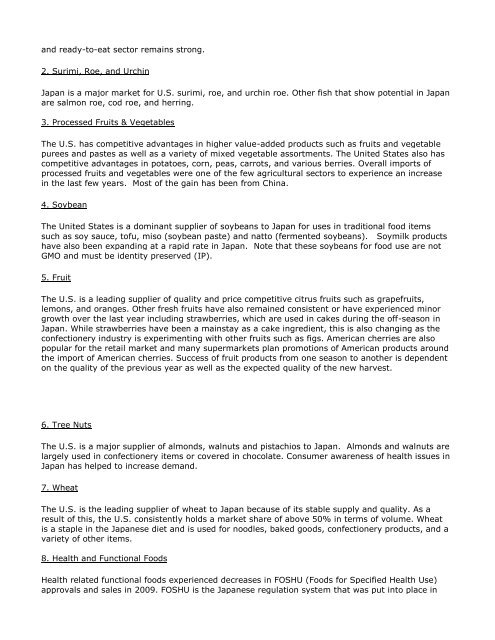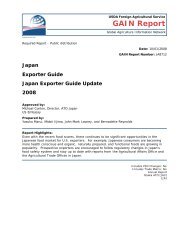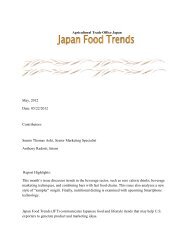Food Processing Sector Food Processing Ingredients Japan
Food Processing Sector Food Processing Ingredients Japan
Food Processing Sector Food Processing Ingredients Japan
Create successful ePaper yourself
Turn your PDF publications into a flip-book with our unique Google optimized e-Paper software.
and ready-to-eat sector remains strong.<br />
2. Surimi, Roe, and Urchin<br />
<strong>Japan</strong> is a major market for U.S. surimi, roe, and urchin roe. Other fish that show potential in <strong>Japan</strong><br />
are salmon roe, cod roe, and herring.<br />
3. Processed Fruits & Vegetables<br />
The U.S. has competitive advantages in higher value-added products such as fruits and vegetable<br />
purees and pastes as well as a variety of mixed vegetable assortments. The United States also has<br />
competitive advantages in potatoes, corn, peas, carrots, and various berries. Overall imports of<br />
processed fruits and vegetables were one of the few agricultural sectors to experience an increase<br />
in the last few years. Most of the gain has been from China.<br />
4. Soybean<br />
The United States is a dominant supplier of soybeans to <strong>Japan</strong> for uses in traditional food items<br />
such as soy sauce, tofu, miso (soybean paste) and natto (fermented soybeans). Soymilk products<br />
have also been expanding at a rapid rate in <strong>Japan</strong>. Note that these soybeans for food use are not<br />
GMO and must be identity preserved (IP).<br />
5. Fruit<br />
The U.S. is a leading supplier of quality and price competitive citrus fruits such as grapefruits,<br />
lemons, and oranges. Other fresh fruits have also remained consistent or have experienced minor<br />
growth over the last year including strawberries, which are used in cakes during the off-season in<br />
<strong>Japan</strong>. While strawberries have been a mainstay as a cake ingredient, this is also changing as the<br />
confectionery industry is experimenting with other fruits such as figs. American cherries are also<br />
popular for the retail market and many supermarkets plan promotions of American products around<br />
the import of American cherries. Success of fruit products from one season to another is dependent<br />
on the quality of the previous year as well as the expected quality of the new harvest.<br />
6. Tree Nuts<br />
The U.S. is a major supplier of almonds, walnuts and pistachios to <strong>Japan</strong>. Almonds and walnuts are<br />
largely used in confectionery items or covered in chocolate. Consumer awareness of health issues in<br />
<strong>Japan</strong> has helped to increase demand.<br />
7. Wheat<br />
The U.S. is the leading supplier of wheat to <strong>Japan</strong> because of its stable supply and quality. As a<br />
result of this, the U.S. consistently holds a market share of above 50% in terms of volume. Wheat<br />
is a staple in the <strong>Japan</strong>ese diet and is used for noodles, baked goods, confectionery products, and a<br />
variety of other items.<br />
8. Health and Functional <strong>Food</strong>s<br />
Health related functional foods experienced decreases in FOSHU (<strong>Food</strong>s for Specified Health Use)<br />
approvals and sales in 2009. FOSHU is the <strong>Japan</strong>ese regulation system that was put into place in





